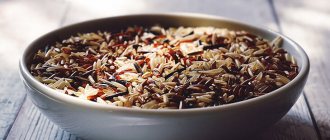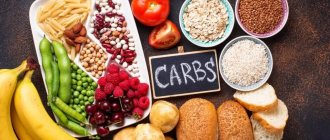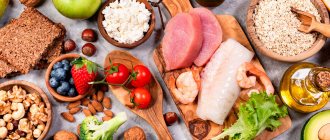In fact, fast carbohydrates are a household term. There are simple carbohydrates (that is, carbohydrates with a simple structure of their constituent molecules) - as well as complex carbohydrates (molecules with a complex structure), which have a rapid absorption rate during digestion.
For example, the starch contained in potatoes is quite a complex carbohydrate. However, in the form of mashed potatoes, the rate of absorption of such starch is quite high. Plus, many refined (processed) carbohydrates are actually simple.
What are carbohydrates?
Carbohydrates are organic substances that are the main source of energy for your body. It is one of the three macronutrients you need to survive. The other two are proteins and fats .
Types of carbohydrates:
- Monosaccharides are the simplest carbohydrates that do not break down into even simpler ones. For example, glucose, fructose.
- Oligosaccharides are more complex compounds, built from several (up to 10) monosaccharide residues. For example, beet raffinose.
- Disaccharides are complex compounds built from 2 monosaccharide residues. For example, beet or cane sugar, lactose (milk sugar).
- Polysaccharides are complex compounds formed from a large number of glucose residues. They are divided into digestible (starch) and non-digestible (fiber). Fiber, due to its properties, has a beneficial effect on the entire body as a whole. Helps prevent many diseases, including cancer.
The meaning of fast carbohydrates
Let's discuss the question that interests us most: fast carbohydrates - what is it for an athlete. Despite the fact that many are skeptical about eating sweets, fast carbohydrates have a place in professional sports. However, you need to clearly understand how simple carbohydrates differ from complex ones, and how to use them correctly in sports.
Simple carbohydrates are great for filling the glycogen window that occurs immediately after finishing a workout.
At the same time, fast carbohydrates are also used to control dopamine levels. Excess energy affects our body no less than caffeine-containing drinks. Fast carbohydrates help improve your emotional state. It is no coincidence that many people, after serious nervous shocks, are drawn to any endorphin and dopamine stimulants (alcohol, nicotine, sweets).
Sweets are much more suitable for restoring the emotional background. We must not forget about the fact that if you have time to waste all the energy that was gained in the process of absorbing sweets, you will not receive any harm from them (source - Borisova O. O.’s monograph “Nutrition for athletes: foreign experience and practical recommendations”).
That is why athletes whose sports involve long-term endurance consume carbohydrate mixtures directly during training or competition.
The simplest example: marathon athletes and many crossfitters who, without adhering to strict diets, do not deny themselves sweets.
Functions of carbohydrates in the human body
- The role of carbohydrates is great. Once in the gastrointestinal tract, they are broken down into glucose, which in turn enters the cells and is used by the body as a source of energy. When they are insufficient to produce energy, proteins and fats break down, which leads to the accumulation of toxic ketones in the blood.
- They are able to accumulate in the liver, skeletal muscles, and other tissues in the form of glycogen.
- They take part in the synthesis of many substances necessary for the normal functioning of your body. For example, complex proteins, components of the immune system, etc.
- Regulates the metabolism of proteins and fats.
- Necessary for the normal functioning of the heart, liver, muscles and central nervous system.
General information
When considering the topic of carbohydrate metabolism in the body, we often touched on the issue of simple (fast) and complex (slow) carbohydrates. It's time to talk about this in more detail.
The main difference between simple and complex carbohydrates is their structure and the rate at which they are absorbed.
Fast carbohydrates are the simplest polymers of sucrose and glucose, consisting of one or two molecules of monosaccharides.
In the body they are broken down into the simplest elements that will transport energy in our blood.
The main difference between fast carbohydrates and slow ones is the speed of the insulin reaction. Glucose compounds that quickly enter the blood occupy the space in tissues and cells that is reserved for oxygen. Therefore, when an excess of carbohydrates (sugar) occurs in the body, the blood thickens and the amount of oxygen in it decreases. For the body, this is a signal that the blood needs to be thinned and make room for oxygen (source - Wikipedia).
This is done in two main ways:
- Insulin reaction.
- Lipid reaction.
The insulin reaction causes blood sugar to bind into glycogen molecules. Insulin itself is a “hole punch” for the cells of our body. It makes holes in the cells, and fills the resulting voids with glycogen molecules - a polysaccharide of glucose residues linked into a chain.
However, this process is only possible if the liver is not overloaded. When the body receives fast carbohydrates in excess, the liver is not always able to digest them all. A backup mechanism is launched that helps process slow and fast carbohydrates - lipid formation. In this case, the liver secretes alkaloids, which complete the structure of carbohydrates, converting them into triglycerides.
© VectorMine — depositphotos.com. Regulating Blood Sugar Levels
The processes described above apply not only to simple, but also complex carbohydrates. The only difference is that the overall digestive system digests different carbohydrates at different rates.
If you consume exclusively slow carbohydrates, the insulin reaction starts much later.
Because there is little sugar in the blood, the body uses it directly as fuel, leaving room for oxygen in the blood. In the case of fast carbohydrates, the insulin reaction malfunctions, and almost the entire excess is transformed exclusively into triglycerides.
© VectorMine — depositphotos.com
What foods contain carbohydrates
Most foods are carbohydrates. They are not found in products of animal origin (meat, fish and seafood, eggs, etc.). The exception is dairy products that contain the milk sugar lactose.
Sources:
- Fruits.
- Vegetables, greens.
- Cereals, different types of flour.
- Nuts and seeds.
- Legumes (beans, peas, lentils, soybeans).
- Bread, pastries, cakes, pastries, etc.
- Pasta, noodles.
- Sugar, starch, honey.
- Carbonated drinks with sugar, compote, juices, tea and coffee with sugar.
- Alcohol.
- Dairy products, etc.
Benefits and harms
Let's look at how carbohydrates affect the body of a professional athlete:
| Benefit | Harm and contraindications |
| Quick replenishment of energy levels | Possible dependence on dopamine stimulation |
| Dopamine stimulation | Contraindicated for people with insufficient thyroid function. |
| Increased performance | Contraindicated for people who suffer from diabetes |
| Restoration of emotional background | Tendency to obesity |
| The ability to close the carbohydrate window with minimal losses | Short-term hypoxia of all tissues |
| Using blood sugar for physical activity | Excessive stress on liver cells |
| Stimulating brain function in the short term | Inability to maintain a calorie deficit |
| The ability to artificially create a microperiodization effect in appropriate nutrition plans | Artificial creation of a feeling of hunger due to the speed of the insulin reaction, and the subsequent optimization processes in the body |
As you can see from the table, there is as much harm from fast carbohydrates as from any other food. At the same time, the advantages of consuming fast carbohydrates for athletes almost completely outweigh their disadvantages.
Recipes for healthy eating
Scrambled eggs with bacon, cheese and champignons
- 15.74 g Protein
- 21.88 g Fat
- 1.39 g Carbohydrates
- 273.69 kcal
10-15 minutes
- #bacon
- #mushrooms
- #breakfast
- #baking
- #green onions
- #dinner
- #cheese
- #dinner
- #Champignon
- #spinach
- #fried eggs
- #egg
Other recipes
Grocery list
Simple carbohydrates
Complex carbohydrates
Why does the body need fast polysaccharides?
They are a source of energy that is necessary for the entire body, in particular the nervous system and muscles. Most people are convinced that sweets improve their mood. This is true. The substance promotes the production of the “happiness hormone” – serotonin. It improves sleep and controls blood pressure.
Please note that many nutritionists call simple carbohydrates a kind of drug that is difficult to give up. This is explained by the sudden production of insulin, to which the body quickly gets used to, requiring a new portion.
You should not completely abandon polysaccharides. Give preference to complex carbohydrates that take a long time to digest, which allows them to enter the blood evenly, thereby not causing sugar spikes.
Be sure to read: Diet with restriction of easily digestible carbohydrates for weight loss
Daily carbohydrate needs
The daily intake will be different for each person.
On the Internet, some sites claim that the carbohydrate norm is 3–5 g per 1 kg of weight. In reality, everything is more complicated. The norm must be calculated for each person individually .
The need depends on gender, age, weight, activity level , etc. Also, your current goals are of great importance. For example, when losing weight and gaining muscle mass, you need completely different amounts of carbohydrates per day.
As an example, calculations were made for a 30-year-old man and woman of average height and low activity. See table below.
In the case of weight gain, average activity was taken (3 workouts per week).
Based on your gender, weight, and weight goals, you can determine your carbohydrate needs. Of course, the figure is approximate, but the error will not be very large.
| 50 -55 kg | 55-60 kg | 60-65 kg | 65-70 kg | 75-80 kg | 80-85 kg | |
| Men | ||||||
| Weight loss | 140 | 145 | 150 | 155 | 160 | 165 |
| Weight maintenance | 160 | 165 | 170 | 175 | 180 | 185 |
| Muscle gain | 270 | 280 | 290 | 300 | 315 | 325 |
| Women | ||||||
| Weight loss | 110 | 115 | 120 | 125 | 135 | 140 |
| Weight maintenance | 130 | 137 | 145 | 150 | 160 | 165 |
| Muscle gain | 228 | 240 | 245 | 255 | 270 | 280 |
When gaining muscle mass, the body needs a lot of energy. In this case, it is recommended to focus on foods high in carbohydrates. Of course, not forgetting about proteins and fats.
Lack of carbohydrates
A deficiency can cause weakness, fatigue, irritability, and apathy. In addition, muscle tissue and fat reserves, as well as proteins and fats supplied with food, will begin to be used as a source of energy.
Excess carbohydrates
Excessive amounts of them lead to a set of extra pounds .
Abuse of simple carbohydrates can lead to diabetes, arterial hypertension, insulin resistance, cardiovascular diseases and cancer.
Complex carbohydrates , on the contrary, can prevent these and other diseases . Fiber plays a big role here.
When the need increases
Since carbohydrates are the main source of energy, the need for them increases with increased mental and physical activity. If you decide to play sports, gain muscle mass, or your new job involves heavy physical activity, increase the amount of carbohydrate-containing foods.
Product table.
| Simple | Complex |
| Honey | Cereals and pasta |
| Sugar | Peas |
| Jams and preserves | Lentils |
| Jam | Beans |
| Carbonated drinks | Beet |
| confectionery | Potato |
| White bread | Carrot |
| Sweet fruits | Pumpkin |
| Sweet vegetables | Cereals and cereals |
| Various syrups | Whole wheat bread |
You can find out how many carbohydrates, and at the same time fats, proteins, water and calories in the section Table of calorie content of foods.
Summarize.
Simple and complex carbohydrates are very important for the human body, both of them, as they participate in basic life processes. But you must remember that carbohydrates need to be burned, otherwise they will be stored in your body as fat reserves.
Easily digestible foods should be limited, as they slow down the breakdown process and participate in the building process, that is, they lead to weight gain. They can also develop dependence on this product. Find strength in yourself and try to control your intake of simple carbohydrates. Include porridge, berries, and fruits in your menu.
I will be glad if this material helps you. If so, share this with your friends on social networks, click on the buttons below. Express your opinion or questions in the comments or on the forum.
Related materials:
- How to burn calories to lose weight?
- Reviews about your weight loss.
- Secrets that will help strengthen your willpower.
- How to get rid of the feeling of hunger?
We recommend reading
Add a comment
What are the dangers of a lack of carbohydrates?
When the body is deprived of its main source of energy, it immediately begins to sound the alarm - this is how it manifests itself:
- dehydration - with a deficiency of carbohydrates, muscles become “donors” of energy, and they consist of 75% water - fluid reserves at this moment are depleted;
- problems with the gastrointestinal tract - beneficial bacteria feed on fiber in complex carbohydrates, and an excess of fatty and protein foods will lead to constipation and bloating;
- poor health - the body takes a lot of energy to break down fats instead of carbohydrates, plus sugar is closely related to the level of dopamine and good mood (the hormone of joy);
- overeating - slow carbohydrates keep you feeling full for a long time - this is due to the fiber in their composition - it gives volume to food and increases the production of hormones GLP-1 and peptide YY - they reduce appetite.
Myths about carbohydrates
Honey is a more dietary product than sugar
In fact, honey contains a lot of minerals and enzymes, and in this respect it is actually healthier than refined sugar. However, honey cannot be called a more dietary product than regular sugar, because it contains the same amount of “sugar” calories. In addition, honey is destroyed by heat treatment, so honey cookies are just cookies with sugar.
Fructose products are healthy
The myth about the benefits of fructose has spread because insulin is not involved in the breakdown of fructose. However, more than 50% of fructose is converted into glucose, and you remember that insulin is needed to utilize it, therefore the “excess” will be stored as fat. In addition, fructose, although to a lesser extent than glucose, affects the production of insulin, it promotes the deposition of fat in the liver, and abuse of fructose can lead to fatty liver.
Sugar is only found in sweets and baked goods
In fact, sugar is found in almost all foods. And starch is added to many finished products (sausages, yoghurts with “additives,” mayonnaise, which we are not inclined to classify as carbohydrates). By drinking a glass of sweet soda, you eat 5 teaspoons of sugar. So you should approach a variety of products very carefully, evaluating them by carbohydrates.
Relevance
Human nutrition comes down to three main components, in particular, proteins, fats and carbohydrates. All of them are vital for any organism. Carbohydrates are considered to be the main supplier of energy (from 50 to 70%). Their deficiency leads to metabolic disorders. The body compensates for the lack of energy through fats and proteins, which leads to a failure of salt metabolism and increased stress on the kidneys.
If this situation persists for a long time, the body begins to use only fats for fuel, and this has a greater effect on the brain cells. Chronic carbohydrate deficiency always causes depletion of glycogen reserves and deposition of fat in liver cells. The liver stops functioning normally and becomes fatty.
What are the dangers of a lack of carbohydrates?
When the body is deprived of its main source of energy, it immediately begins to sound the alarm - this is how it manifests itself:
- dehydration - with a deficiency of carbohydrates, muscles become “donors” of energy, and they consist of 75% water - fluid reserves at this moment are depleted;
- problems with the gastrointestinal tract - beneficial bacteria feed on fiber in complex carbohydrates, and an excess of fatty and protein foods will lead to constipation and bloating;
- poor health - the body takes a lot of energy to break down fats instead of carbohydrates, plus sugar is closely related to the level of dopamine and good mood (the hormone of joy);
- overeating - slow carbohydrates keep you feeling full for a long time - this is due to the fiber in their composition - it gives volume to food and increases the production of hormones GLP-1 and peptide YY - they reduce appetite.
Simple carbohydrates without harm to your figure
To prevent “fast” foods from forcing you to make a new hole in your belt, follow two principles for eating them:
1. Right time. Do you like sweets? Eat it only in the first half of the day. It will be easier for your body to process glucose before lunch, so dessert won't hurt your waistline. The closer it gets to the evening, the higher the likelihood that fast carbohydrates will turn into extra pounds. It is recommended to avoid them for dinner.
2. The right combination. Pectin, proteins and fiber slow down the absorption of sugars. So look for alternatives to your favorite treats. An oven-baked apple, marmalade or cottage cheese with prunes and dried apricots is safer for the figure than puff Napoleon or cream rolls.
Just two points. But if you follow them, then you will not be embarrassed about your reflection in the mirror.
Why do fast carbohydrates cause you to gain weight?
The fact that simple carbohydrates work faster than their “healthy” counterparts is understandable. Why do people get fat because of them? Because they break down instantly - the body simply does not have time to spend them. As long as the body carries glucose through the blood, you feel full. But as soon as blood glucose levels rise above 100 mg/dL, insulin pushes glucose into fat cells. When insulin does its job, you want to eat again.
In theory, this is what happens: fast carbohydrate – a jump in sugar and insulin – hunger and overeating. But in practice, a person rarely consumes pure carbohydrates - usually the product also contains a lot of fat. For example, 100 g of chocolate contains approximately 50 g of carbohydrates and 34 g of fat - and they contain twice as many calories as carbohydrates. The vicious circle can be broken if you limit portions - eat, for example, not a bar of chocolate, but only a slice. But ideally, replace it with fruit - the same apple contains only 10 g of carbohydrates and 0.4 g of fat.
Glycemic index indicator
The glycemic index (GI) is an indicator that reflects the rate at which carbohydrates are absorbed by the body. The term itself was coined by Canadian nutritionist David Jenkins at the end of the last century; it is relevant primarily for diabetics, since it is precisely people suffering from this disease who need to correctly monitor any sugar entering the body.
As a result of long studies, during which the reaction of blood sugar levels to the intake of glucose in its pure form was studied, tables were obtained with glycemic index data for a wide variety of foods.
In his research, David Jenkins revealed the dependence of a person’s well-being on the amount of carbohydrates consumed. With a normal level of glucose in the blood, active performance and a cheerful state are observed. If sugar rises or falls sharply, this is manifested by a decrease in activity and a feeling of fatigue. Conclusion: to maintain excellent well-being and an energetic state, it is necessary to control the level of sugar and insulin in the blood and avoid sudden jumps.
To classify foods according to the glycemic index, we took a glucose GI value of 100 as a basis and divided into three index categories:
- low – below 55;
- average – from 55 to 70;
- high – over 70.
Glycemic index indicator
Constant excessive consumption of foods with a high GI and, accordingly, containing fast carbohydrates, negatively affects the overall well-being and health of a person. They do not nourish the body qualitatively, but only give a short-term feeling of fullness.
In addition, if the sugar that enters the blood is not converted into glycogen through physical activity, then there is a risk of turning it into fat deposits. It is for these reasons that it is recommended to consume fast carbohydrates in limited quantities.
When there is a question about losing weight, it is necessary to structure your diet in such a way that the bulk of it consists of foods with a low GI, less than 55. In addition to a slim figure, a person will receive excellent well-being as a bonus.
How many simple polysaccharides can you eat per day?
If you cannot exclude unhealthy foods from the menu, then eat them in the first half of the day. This will allow you to quickly restore the energy reserves lost during sleep. After lunch, it is better to refuse the delicious cake, leaving it until the next morning.
Be sure to read: Healthy fats: list of foods, what are the benefits, what can you eat when losing weight, daily intake
The permissible dose of organic matter is different for each person depending on individual parameters. The body requires 3 grams of this substance per kilogram of weight. Based on this, you can independently calculate the required dose.
For example, a person weighs 80 kg, which means he can eat up to 300 grams. Please note: if you lead a sedentary lifestyle, the amount of substance per 1 kg will have to be reduced to 2 g.











